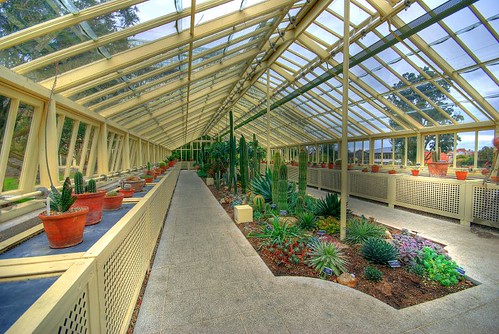My good buddy Rory Hogan is a talented photographer and has some outstanding photos on Flickr. My own favourites are his superb studies of one of my favourite places and a childhood haunt in Dublin, the National Botanic Gardens at Glasnevin.
>
http://daithaic.blogspot.com/2008/01/botanic-gardens-glasnevin-dublin_31.html
For more gardening Blogs see on my Blog Sidebar under "Hortus Praetorius" - Latin for "Head Gardener"!
Look up Rory's work on;
http://www.flickr.com/photos/roryhogan/
One of the undoubted unsung joys of Ireland’s Capital City of Dublin are its delightful Botanic Gardens set in its Northside suburb of Glasnevin around 3 miles from the city centre. Glasnevin is a village which was been swallowed up by the city’s expansion in the 1900’s but still has much charm and character due to its setting along the Tolka River and numerous historical and literary associations including with the poet Joseph Addison and the satirist Jonathan Swift, Dean of St. Patrick’s Cathedral and author of “Gulliver’s Travels”. It is a place I’m particularly fond of as my parents live not too far away and I went to junior school nearby so the gardens were my childhood happy hunting grounds after school. Even today they are a serious horticultural celebration with little commercialism and unlike Kew Gardens in London which charges a disgraceful £12.25 pounds entrance fee, here entry is free.


The Great Palm House
The Palm House Complex at the National Botanic Gardens, Glasnevin, Dublin, won a top European award for its restoration, the 2006 European Union Prize for Cultural Heritage / Europa Nostra Medal.
Dating from 1884, the Great Palm House at the National Botanic Gardens was magnificently and faithfully restored over a two year period by the Office of Public Works (OPW) until its completion and reopening in 2004.
Costing £800 when it was built in 1884, the Great Palm House, which was made of wood and iron, was prefabricated in the Scottish town of Paisley by James Boyd & Son. It was shipped to Ireland in pieces, then assembled on site: a Victorian flat-pack greenhouse, 65 feet high, 80 feet wide and 100 feet long. In 2004 it reopened to the public after a lengthy restoration which saw it dismantled, conserved and repaired and reassembled.

Scarecrow

Walk in Sepia


A River runs through it - The River Tolka and a canal run through the gardens providing extra visual interest



Venus Fly Trap
The Venus Flytrap, Dionaea muscipula, is a carnivorous plant that catches and digests animal prey—mostly insects and arachnids. Its trapping structure is formed by the terminal portion of each of the plant's leaves and is triggered by tiny hairs on their inner surfaces. When an insect or spider crawling along the leaves comes into contact with one or more of the hairs twice in succession, the trap closes. The requirement of redundant triggering in this mechanism serves as a safeguard against a waste of energy in trapping objects with no nutritional value.



Orchid
The orchid family includes 20,000 to 30,000 species and more than 70,000 hybrids or cultivars. The largest number, and most popular, come from Asia. South America is also rich in wild orchids.
Orchids have two main ways of growing:
Monopodial growth - one, usually upright, axis from which leaves appear.
Sympodial growth - the axis is a prostrate rhizome from which shoots appear. Many sympodials develop pseudobulbs, thickened shoots from which the leaves grow. These act as storage organs for water and nutrients.
Within these two broad groups, orchid can be narrowed down to four types:
Terrestrial orchids - have their roots in soil.
Climbing epiphytes - found in tree tops, with roots clinging to the bark to absorb nutrients and water.
Lithophytes - grow on rocks or in very little soil.
Saprophytes - get their nutrition from dead or decaying matter through symbiotic relationships with fungi.



Strelitzia
Strelitzia is a genus of five species of perennial plants, native to South Africa. The genus is named after the duchy of Mecklenburg-Strelitz, birthplace of Queen Charlotte of the United Kingdom, wife of George III. The common name of the genus is bird of paradise flower, because of a supposed resemblance of its flowers to the bird of paradise. In South Africa it is commonly known as a crane flower.


Sequoia
Sequoia sempervirens is the sole living species of the genus Sequoia in the cypress family Cupressaceae. Common names include Coast Redwood and California Redwood (it is one of three species of trees known as redwoods, but "redwood" per se normally refers to this species). It is an evergreen, long-lived, monoecious tree living for up to 2,200 years, and this species includes the tallest trees on Earth, reaching up to 115.5 m (379.1 ft) in height and 8 m (26 ft) diameter at breast height. It is native to coastal California and the south-western corner of Oregon within the United States. Sequoias are the oldest living species on the Earth.

The National Botanic Gardens at Glasnevin is Ireland's premier botanical and horticultural establishment and is a rewarding and attractive garden for gardeners and non-gardeners alike containing over 20,000 different plant species and cultivars including many exceptional specimens. It provides an excellent visitor attraction and an oasis of peace and tranquility a short distance from Dublin’s bustling city centre by taxi or on bus routes 11, 13 or 19. With its excellent visitor centre, restaurant and informative layout and signage it is a good place both to absorb the beauty of the gardens and recharge your own batteries.


National Botanic Gardens
Glasnevin
Dublin 9
Ireland.
Telephone No: + 353 1 804 0300
Fax No: + 353 1 836 0080
Website http://www.botanicgardens.ie

The bell which is rung from 15 minutes before closing time to warn visitors to leave

No comments:
Post a Comment